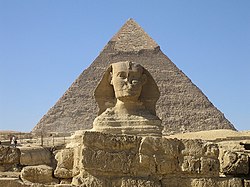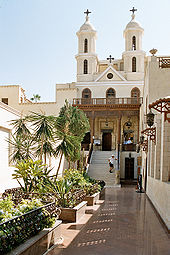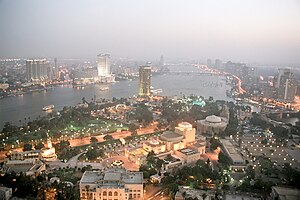History

The Nile has been a site of continuous human habitation since at least the Paleolithic era. Evidence of this appears in the form of artifacts and rock carvings along the Nile terraces and in the desert oases. In the 10th millennium BC, a culture of hunter-gatherers and fishers replaced a grain-grinding culture. Climate changes and/or overgrazing around 8000 BC began to desiccate the pastoral lands of Egypt, eventually forming the Sahara. Early tribal peoples migrated to the Nile River where they developed a settled agricultural economy and more centralized society.[8]
By about 6000 BC, organized agriculture and large building construction had appeared in the Nile Valley. During the Neolithic, several predynastic cultures developed independently in Upper and Lower Egypt. The Badarian culture and the successor Naqada series are generally regarded as precursors to Dynastic Egyptian civilization. The earliest known Lower Egyptian site, Merimda, predates the Badarian by about seven hundred years. Contemporaneous Lower Egyptian communities coexisted with their southern counterparts for more than two thousand years, remaining somewhat culturally separate, but maintaining frequent contact through trade. The earliest known evidence of Egyptian hieroglyphic inscriptions appear during the predynastic period on Naqada III pottery vessels, dated to about 3200 BC.[9]
| tAwy ('Two Lands') in hieroglyphs | ||
|
A unified kingdom was founded circa 3150 BC by King Menes, giving rise to a series of dynasties that ruled Egypt for the next three millennia. Egyptians subsequently referred to their unified country as tAwy, meaning 'Two Lands'; and later km.t (Coptic: Kīmi), the 'Black Land', a reference to the fertile black soil deposited by the Nile river. Egyptian culture flourished during this long period and remained distinctively Egyptian in its religion, arts, language and customs. The first two ruling dynasties of a unified Egypt set the stage for the Old Kingdom period, c.2700−2200 BC., famous for its many pyramids, most notably the Third Dynasty pyramid of Djoser and the Fourth Dynasty Giza Pyramids.

The First Intermediate Period ushered in a time of political upheaval for about 150 years. Stronger Nile floods and stabilization of government, however, brought back renewed prosperity for the country in the Middle Kingdom c. 2040 BC, reaching a peak during the reign of Pharaoh Amenemhat III. A second period of disunity heralded the arrival of the first foreign ruling dynasty in Egypt, that of the Semitic Hyksos. The Hyksos invaders took over much of Lower Egypt around 1650 BC, and founded a new capital at Avaris. They were eventually driven out by an Upper Egyptian force led by Ahmose I, who founded the Eighteenth Dynasty and relocated the capital from Memphis to Thebes.
The New Kingdom (c.1550−1070 BC) began with the Eighteenth Dynasty, marking the rise of Egypt as an international power that expanded during its greatest extension to an empire as far south as Jebel Barkal in Nubia, and included parts of the Levant in the east. This period is known for some of the most well-known Pharaohs, including Hatshepsut, Thutmose III, Akhenaten and his wife Nefertiti, Tutankhamun and Ramesses II. The first known self-conscious expression of monotheism came during this period in the form of Atenism. Frequent contacts with other nations brought in new ideas in the New Kingdom. The country was later invaded by Libyans, Nubians and Assyrians, but native Egyptians drove them out and regained control of their country.

The Thirtieth Dynasty was the last native ruling dynasty during the Pharaonic epoch. It fell to the Persians in 343 BC after the last native Pharaoh, King Nectanebo II, was defeated in battle. Later, Egypt fell to the Greeks and Romans, beginning over two thousand years of foreign rule. Before Egypt became part of the Byzantine realm, Christianity had been brought by Saint Mark the Evangelist in the AD first century. Diocletian's reign marks the transition from the Roman to the Byzantine era in Egypt, when a great number of Egyptian Christians were persecuted. The New Testament was by then translated into Egyptian, and after the Council of Chalcedon in AD 451, a distinct Egyptian Coptic Church was firmly established.[10]
The Byzantines were able to regain control of the country after a brief Persian invasion early in the seventh century, until in AD 639, Egypt was invaded by the Muslim Arabs. The form of Islam the Arabs brought to Egypt was Sunni, though early in this period Egyptians began to blend their new faith with indigenous beliefs and practices that had survived through Coptic Christianity, giving rise to various Sufi orders that have flourished to this day.[11] Muslim rulers nominated by the Islamic Caliphate remained in control of Egypt for the next six centuries, including a period for which it was the seat of the Caliphate under the Fatimids. With the end of the Ayyubid dynasty, a Turco-Circassian military caste, the Mamluks, took control about AD 1250 and continued to govern even after the conquest of Egypt by the Ottoman Turks in 1517.
The brief French Invasion of Egypt led by Napoleon Bonaparte in 1798 had a great social impact on the country and its culture. Native Egyptians became exposed to the principles of the French Revolution and had an apparent chance to exercise self-governance.[12] A series of civil wars took place between the Ottoman Turks, the Mamluks, and Albanian mercenaries following the evacuation of French troops, resulting in the Albanian Muhammad Ali (Kavalali Mehmed Ali Pasha) taking control of Egypt where he was appointed as the Ottoman viceroy in 1805. He led a modernization campaign of public works, including irrigation projects, agricultural reforms and increased industrialization, which were then taken up and further expanded by his grandson and successor Isma'il Pasha.
Following the completion of the Suez Canal by Ismail in 1869, Egypt became an important world transportation hub. In 1866, the Assembly of Delegates was founded to serve as an advisory body for the government. Its members were elected from across Egypt and eventually they came to have an important influence on governmental affairs.[13] The country also fell heavily into debt to European powers. Ostensibly to protect its investments, the United Kingdom seized control of Egypt's government in 1882. Nominal allegiance to the Ottoman Empire continued, however, until 1914. As a result of the declaration of war with the Ottoman Empire, Britain declared a protectorate over Egypt and deposed the Khedive Abbas II, replacing him with his uncle, Husayn Kamil, who was appointed Sultan.

Between 1882 and 1906, a local nationalist movement for independence was taking shape. The Dinshaway Incident prompted Egyptian opposition to take a stronger stand against British occupation and the first political parties were founded. After the first World War, Saad Zaghlul and the Wafd Party led the Egyptian nationalist movement after gaining a majority at the local Legislative Assembly. When the British exiled Zaghlul and his associates to Malta on March 8, 1919, Egypt witnessed its first modern revolution. Constant revolting by the Egyptian people throughout the country led Great Britain to issue a unilateral declaration of Egypt's independence on February 22, 1922.[14]
The new Egyptian government drafted and implemented a new constitution in 1923 based on a parliamentary representative system. Saad Zaghlul was popularly-elected as Prime Minister of Egypt in 1924, and in 1936 the Anglo-Egyptian Treaty was concluded. Continued instability in the government due to remaining British control and increasing political involvement by the king led to the ouster of the monarchy and the dissolution of the parliament in a military coup d'état known as the 1952 Revolution. The officers, known as the Free Officers Movement, forced King Farouk to abdicate in support of his son Fuad.

The Egyptian Republic was declared on 18 June 1953 with General Muhammad Naguib as the first President of the Republic. Naguib was forced to resign in 1954 by Gamal Abdel Nasser – the real architect of the 1952 movement – and was later put under house arrest. Nasser assumed power as President and declared the full independence of Egypt from the United Kingdom on June 18, 1956. His nationalization of the Suez Canal on July 26, 1956 prompted the 1956 Suez Crisis. Three years after the 1967 Six Day War, in which Israel had invaded an occupied Sinai, Nasser died and was succeeded by Anwar Sadat. Sadat switched Egypt's Cold War allegiance from the Soviet Union to the United States, expelling Soviet advisors in 1972, and launched the Infitah economic reform policy, while violently clamping down on religious and secular opposition alike.
In 1973, Egypt, along with Syria, launched the October War, a surprise attack against the Israeli forces occupying the Sinai Peninsula and the Golan Heights in an attempt to liberate the territory Israel had captured 6 years earlier. Both the US and the USSR intervened and a cease-fire was reached between both sides. Despite not being a complete military success, most historians agree that the October War presented Sadat with a political victory that would later allow him to pursue peace with Israel. In 1977, Sadat made a historic visit to Israel which led to the 1978 peace treaty in exchange for the complete Israeli withdrawal from Sinai. Sadat's initiative sparked enormous controversy in the Arab world and led to Egypt's expulsion from the Arab League, but was supported by the vast majority of Egyptians.[15] Sadat was assassinated in Cairo by a fundamentalist military soldier in 1981 and was succeeded by the incumbent Hosni Mubarak. In 2003, the Egyptian Movement for Change, popularly known as Kifaya, was launched to seek a return to democracy and greater civil liberties.
Identity
The Egyptian Nile Valley was home to one of the oldest cultures in the world, spanning three thousand years of continuous history. When Egypt fell under a series of foreign occupations after 343 BC, each left an indelible mark on the country's cultural landscape. Egyptian identity evolved in the span of this long period of occupation to accommodate in principal two new religions, Christianity and Islam, and a new language, Arabic, and its spoken descendant, Egyptian Arabic. The degree with which these factors are estimated today by different groups in Egypt in articulating a sense of collective identity can vary greatly, and therefore continue to be a source of frequent debate.
Questions of identity came to fore in the last century as Egypt sought to free itself from foreign occupation for the first time in two thousand years. Three chief ideologies came to head and would eventually compete with one another (and continue to do so to this day): ethno-territorial Egyptian nationalism (and by extension Pharaonism), secular Arab nationalism (and by extension pan-Arabism) and Islamism. Egyptian nationalism predates its Arab counterpart by many decades, having roots in the nineteenth century and eventually becoming the dominant mode of expression of Egyptian anti-colonial activists of the pre- and inter-war periods. It was nearly always articulated in exclusively Egyptian terms:
| “ | What is most significant [about Egypt in this period] is the absence of an Arab component in early Egyptian nationalism. The thrust of Egyptian political, economic, and cultural development throughout the nineteenth century worked against, rather than for, an "Arab" orientation... This situation—that of divergent political trajectories for Egyptians and Arabs—if anything increased after 1900.[16] | ” |
In 1931, Syrian Arab nationalist Sati' al-Husri remarked following a visit to Egypt that "[Egyptians] did not possess an Arab nationalist sentiment; did not accept that Egypt was a part of the Arab lands, and would not acknowledge that the Egyptian people were part of the Arab nation."[17] Incidentally, the later 1930s would become a formative period for Arab nationalism in Egypt, thanks in large part to efforts by Syrian/Palestinian/Lebanese intellectuals.[18] Yet a year after the establishment of the League of Arab States in 1945 to be headquartered in Cairo, Oxford University historian H. S. Deighton was still writing:
| “ | The Egyptians are not Arabs, and both they and the Arabs are aware of this fact. They are Arabic-speaking, and they are Muslim—indeed religion plays a greater part in their lives than it does in those either of the Syrians or the Iraqi. But the Egyptian, during the first thirty years of the [twentieth] century, was not aware of any particular bond with the Arab East... Egypt sees in the Arab cause a worthy object of real and active sympathy and, at the same time, a great and proper opportunity for the exercise of leadership, as well as for the enjoyment of its fruits. But she is still Egyptian first and Arab only in consequence, and her main interests are still domestic. [19] | ” |
It was not until the Nasser era more than a decade later that Arab nationalism became a state policy and a means with which to define Egypt's position in the Middle East and the world,[20] usually articulated vis-à-vis Zionism in the neighbouring Jewish state. For a while Egypt and Syria formed the United Arab Republic, and when the union was dissolved, it eventually gave rise to the current official name, Arab Republic of Egypt. Egypt's attachment to Arabism, however, was particularly questioned after its defeat in the 1967 Six-Day War, when thousands of Egyptians lost their lives and the country become disillusioned with Arab politics.[21] Nasser's successor Sadat, both by policy and through his peace initiative with Israel, revived an uncontested Egyptian particularist orientation, unequivocally asserting that only Egypt was his responsibility, and the terms "Arab", "Arabism" and "Arab unity", save for the new official name, became conspicuously absent.[22] Indeed, as professor of Egyptian history P. J. Vatikiotis explains:
| “ | ...the impact of the October 1973 War (also known as the Ramadan or Yom Kippur War) found Egyptians reverting to an earlier sense of national identity, that of Egyptianism. Egypt became their foremost consideration and top priority in contrast to the earlier one, preferred by the Nasser régime, of Egypt's role and primacy in the Arab world. This kind of national 'restoration' was led by the Old Man of Egyptian Nationalism, Tawfiq el-Hakim, who in the 1920s and 1930s was associated with the Pharaonist movement.[23] | ” |
The question of identity continues to be debated today with many Egyptians perhaps falling somewhere in the middle, considering themselves Egyptian first but finding Egyptian and Arab identities linked and not necessarily incompatible. Others identify themselves mainly on the basis of their religion. The sentiment, however, that Egypt and Egyptians are simply not Arab, emphasizing indigenous Egyptian heritage, culture and independent polity, and publicly voicing objection to the present official name, is frequently expressed. This can be found among Egyptians themselves[24], including Secretary General of the Supreme Council of Antiquities Zahi Hawass[25], popular writer Osama Anwar Okasha, Egyptian-born Harvard University Professor Leila Ahmed, Member of Parliament Suzie Greiss[26] and different local groups and intellectuals[27][28][29][30][31], but also in in various contexts.[32][33] These include Neil DeRosa's novel Joseph's Seed in his depiction of an Egyptian character "who declares that Egyptians are not Arabs and never will be."[34] Egyptian critics of Arab nationalism contend that it has worked to erode and/or relegate native Egyptian identity by superimposing only one aspect of Egypt's culture.
These conflicting views and sources for collective identification in the Egyptian state are captured in the words of a linguistic anthropologist who conducted fieldwork in Cairo:
| “ | Historically, Egyptians have considered themselves as distinct from 'Arabs' and even at present rarely do they make that identification in casual contexts; il-'arab [the Arabs] as used by Egyptians refers mainly to the inhabitants of the Gulf states who are on the whole looked upon with some disdain... Egypt has been both a leader of pan-Arabism and a site of intense resentment towards that ideology. Egyptians had to be made, often forcefully, into "Arabs" [during the Nasser era] because they did not historically identify themselves as such. Egypt was self-consciously a nation not only before pan-Arabism but also before becoming a colony of the British Empire. Its territorial continuity since ancient times, its unique history as exemplified in its pharaonic past and later on its Coptic language and culture, had already made Egypt into a nation for centuries. Egyptians saw themselves, their history, culture and language as specifically Egyptian and not "Arab." |





Tidak ada komentar:
Posting Komentar